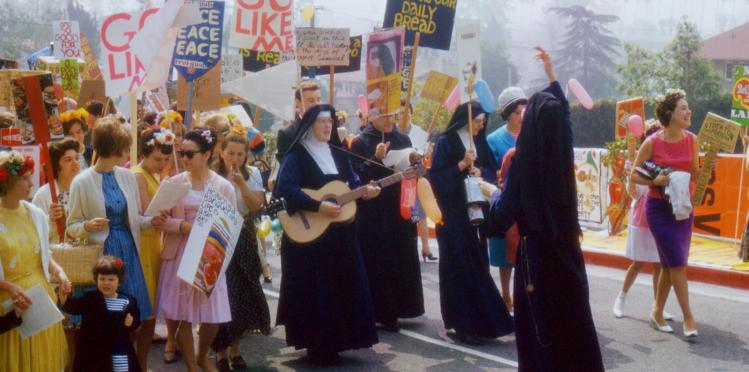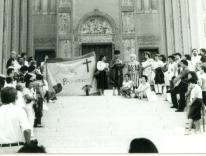
“Damn everything that is grim, dull, motionless, unrisking, inward turning, damn everything that won’t get in the circle, that won’t enjoy, that won’t throw its heart into the tension, surprise, fear and delight of the circus, the round world, full of existence....”
-Sr. Helen Kelley, President of Immaculate Heart Community (1993–1996)
Visually incantatory and deeply affecting, Rebel Hearts takes us on a journey through a singularly important moment in modern Catholic history. Using a wide array of sources, including archival television footage and one-on-one interviews, and saturated with the flower-power colors of pop art, including Una Lorenzen’s ingenious animation (think Yellow Submarine meets Madeline), the film tells the story of the sisters of the Los Angeles congregation of the Immaculate Heart of Mary (IHM), who were responsible for educating thousands of children in the Catholic school system during the city’s postwar population boom. The film depicts the sisters laboring under exploitative conditions, eventually clashing with their diocese’s unyielding and parsimonious “education Cardinal,” James Francis McIntyre, whose ecclesial authority the women, with their smarts and their principles, both overwhelmed and undermined. Led by their astute and courageous mother general, Anita Caspary, during their most tumultuous years (1963–73), the sisters held fast to both their commitment to the role of conscience in religious life and their confidence in the righteousness of their own decision-making. They attracted national attention for how their story played out against the wider cultural clashes of the feminist movement and for helping fuel the renewal associated with the Second Vatican Council. Rebel Hearts provides a slice of the cultural revolution of the ’60s and ’70s as experienced by an extraordinary group of women nestled in the heart of Hollywood. Without sacrificing the particularities of its tale, the film still conveys the universal power of courage and creativity to ignite and sustain individual lives and communities.
Twenty years in the making, Rebel Hearts was conceived of by producer Shawnee Isaac Smith, who co-wrote the documentary with Erin Barnett. (It is directed by Pedro Kos.) In spite of its long gestation, it never feels stale thanks to the easy unfolding of its narrative arc. This is in part because the film coaxes individual personalities into view via a series of interviews, some conducted by major television network personalities in the 1960s and ’70s, when the IHM sisters achieved something like celebrity status, and some conducted more recently by the filmmakers. We thus hear from the sisters at various points in their youth, middle age, and old age, with an intimacy more frequently reserved for family.
We learn from Caspary that she was a student at the sisters’ Immaculate Heart College, where her teachers became her models. After graduating in 1936, she joined the congregation and went on to receive her PhD in English from Stanford University. There is a long history of women like Caspary, for whom single-sex religious communities were an alternative marriage and motherhood, offering instead opportunities for education and support for intellectual pursuits. But the fantasy of an expansive life of the mind was compromised for Caspary and many of her sisters: freedom from a controlling male presence remained distant from their day-to-day reality, with the longed-for life of the mind undermined by the relentless tedium of household obligations and the thirst for spiritual investigation dulled by rote learning. Interviewees recount long hours polishing, dusting, and memorizing the Catechism, a sequence of chores each as desiccating as the other. The filmmakers juxtapose black-and-white stills of the sisters in full-length habits, coifs and veils in place, with colorful magazine advertisements of women attired in happy-housewife, bodice-bearing smocks and brandishing feather dusters with aplomb. The film makes its point: the nuns traded one authority for another; women are to serve men, and in the garb of their preference, body-hiding or body-hugging, depending on male proclivities.
Rebel Hearts portrays the community pitted against McIntyre, who was a runner on the New York Stock exchange before he entered the priesthood and brought Wall Street savvy with him to Los Angeles, overseeing unprecedented growth in Catholic parochial and high-school enrollment. The IHMs provided the greater portion of his teachers. A cheap and, McIntyre must have supposed, docile workforce, they frequently taught seventy or eighty children in each classroom. The majority of women had neither training nor experience. Says one sister, all they felt was defeat. “I think Cardinal McIntyre saw women, at least nuns, as coolie labor for his schools,” one sister remarks, as a cartoon image of nuns placed on a conveyor belt, like so many mass-produced dolls, takes over the screen. “We realized that our labor problem was at the root of everything else.... I can hear the cardinal telling us you aren’t going to tell me how to run my schools,” another remembers. The women stood firm for better working conditions, including smaller class sizes and greater institutional support, feeding the anger of their boss.
A different spirit, one of mutual support and open inquiry, reigned at the sisters’ Immaculate Heart College, whose all-female professoriate had more degrees than all the priests in the diocese of Los Angeles, and who took up their task as researchers and educators with a confidence and ambition that threatened the clergy. Photographs and film capture classrooms crammed with tools of investigation and creation—scientific apparatuses, books, musical instruments, paintbrushes—conveying the exuberance that accompanies the love of learning, which the sisters cultivated and which fed the community’s devotional life. Students and teachers collaborated to replace staid Mary’s Day processions with a boisterous paean to her role in recreation. “God Likes Me,” a hot-pink lettered sign proclaims. “Peace, Peace, Peace,” reads another, as women in full habit and crowned with wreaths of flowers strum guitars alongside their students, dressed in bursting purples, blues, and yellows and waving giant paper sunflowers, all jostling for our attention against a southern California landscape of palms and pines, together proclaiming the grandeur of creation and celebrating human creativity.
“In those days, I was surrounded by some of the best women you could ever meet.... I’m sure if I had been a nice proper housewife I would not have bumped into any of these ideas,” says Corita Kent, Caspary’s contemporary and the community’s most well-known member, who taught her students to scout supermarkets for source material, to mine for meaning in everyday banality, and to wonder at the hidden gems of L.A.’s landscape, littered with gas stations and garages. Although the Los Angeles Times hailed Kent as one of its 1966 “Women of the Year,” and Newsweek featured her on its cover—“the nun going modern”—in 1967, she was overshadowed in art by big boys such as Andy Warhol and Robert Indiana. “Mary Mother is the juiciest tomato of all,” her take on the Del Monte slogan, is a one-upping of Warhol’s Campbell Soup canvasses, a text-heavy offering for ecclesial renewal, a silkscreen in red, yellow, orange, and white. The piece was a breaking point for McIntyre, its mingling of the mundane and the holy an affront to his more tidily organized sensibility. “You will suffer” for this, he promises the congregation, one of the several hold-your-breath moments this film provides.
Energized by a growing attentiveness to the world around them, the sisters took their enthusiasm for engaging with it outside the college. A clip captures them dancing with their students among the stars on Hollywood Boulevard. “Perhaps everything terrible,” one of Kent’s silkscreens reads, quoting Rilke, “is in its deepest being something that wants help from us.” She and her sisters responded to contemporary demands for justice by marching in Selma in 1965, protesting the war in Vietnam, and linking arms with California farmworkers. The “college always provided an alternative education,” we hear one sister say, “but it was the years ’63 to ’70 where everything was popping.” Catholics more tightly bound to the trappings of tradition began keeping their daughters away from the college. The film only hints at the larger Los Angeles Catholic context of the sisters’ activism and the political engagement the IHMs inspired. A National Catholic Reporter article suggests the power of the sisters’ words and example. Sue Welsh, a graduate of the Immaculate Heart College and one of many who decried McIntyre’s racist disregard for his Black parishioners, recalls her involvement with Catholics for Racial Equality: “We had marches, sit-ins, and even a torch-light procession in front of the cardinal’s home.… After I appeared on the NBC news that night, they sent two priests to my house looking for me. It was crazy. They called us communists and outside agitators from their pulpits. We were just putting into action what we learned from Catholic schools.”
The professors’ intellectual and artistic pursuits (the sisters acquired federal grants for their scientific research and recorded Schubert’s Piano Trio No. 2 in E-Flat Major for Capitol Records, while the 1964–65 World’s Fair’s Vatican Pavilion featured a 4x40 mural by Kent) generated widespread attention. This, joined to the sisters’ political activism, infuriated their increasingly embattled archbishop. Responding to the Vatican’s urging of religious orders to examine their way of life, the women engaged in a process of communal discernment, culminating in a vote to make their wearing of the habit optional, reduce class sizes, commit to teacher training, and maintain flexibility in prayer practices. The sisters “drifted away from authority, and that was really the problem,” says Msgr. Clement Connolly, a former secretary to McIntyre, and one gets the feeling Connolly enjoys saying of his former boss: “That cardinal was not going to put up with those uppity women.”
McIntyre soon called for a Vatican delegation to investigate the congregation. (This may bring to mind for some the Vatican visitation to every house of American nuns in 2013, which sent a chill through many communities.) When the IHMs refused to budge, McIntyre removed them from their teaching positions, a shot aimed at women religious more broadly. His message was clear: do not challenge ecclesial authority. The archbishop had reason to worry, and his assault on the teachers and their students (many of the schools the sisters staffed closed, with the poorest hit hardest) would bear the fruit of discontent and rebellion. The congregation subsequently divided. A minority would remain under the authority of the archdiocese, while more than three hundred IHM sisters requested to be released from their vows. A contingent of more than two hundred former IHM sisters established the Immaculate Heart Community (“the Community”), a lay Christian ecumenical community that celebrated its fiftieth anniversary in 2020. The Community, which takes Mary as its model in its commitment to the world, remains a vibrant presence in the religious, cultural, and political orbit of Los Angeles.
Even as the film trains its focus on the Community and former sisters, IHMs have continued to make headlines. Just in time for Rebel Hearts’s summer release, the Los Angeles City Council designated historic-cultural monument status to the unassuming beige building that was Kent’s studio in Hollywood. A more widely covered story was the lawsuit brought by IHM sisters Rita Callahan and Catherine Holzman against Los Angeles Archbishop José Gomez in 2015 over the archdiocese’s $14.5 million sale of the IHM’s 22,000-square-foot convent to pop star Katy Perry. The sisters contended that the property was not the archdiocese’s to sell. Holzman died during a court appearance in 2018, and the court ultimately ruled for Gomez.
“There is a sense in which we have always been in trouble,” a sixty-something former IHM sister recounts in Rebel Hearts. She is right: decades of obedience provided Callahan and Holzman no protection when they dared to question the archbishop’s authority. According to Callahan, Holzman spent her final years squeezed into poverty—the diocese, not Holzman, had control over her bank account, and she lived on borrowed money and relied on charity for food.
But this film is not about Gomez or McIntyre. Rebel Hearts releases its audience sunny-side-up, the documentary bubbling with enthusiasm for the way in which former IHM sisters navigated their lives outside the convent and for their legacy. The filmmakers have given us an invigorating joy-filled ride in their tribute to an often maligned, routinely undervalued population of women.
As the documentary winds down, we meet Rosa Manriquez, a member of the Immaculate Heart Community. Educated as a girl by the IHM sisters and graduating from Immaculate Heart College, Manriquez married and raised a family before being ordained by the Roman Catholic Womenpriests. She is one of more than one hundred women to flout the 2007 decree of the Congregation for the Doctrine of the Faith, which pronounced the penalty of excommunication against anyone “who attempts to confer a sacred order on a woman, and the woman who attempts to receive a sacred order.” The IHM sisters taught Manriquez to follow her conscience, and this is the lasting message of Rebel Hearts.
Please email comments to [email protected] and join the conversation on our Facebook page.
Previous Story
Persuading Anti-vaxxers
Next Story
An Unwinnable War

